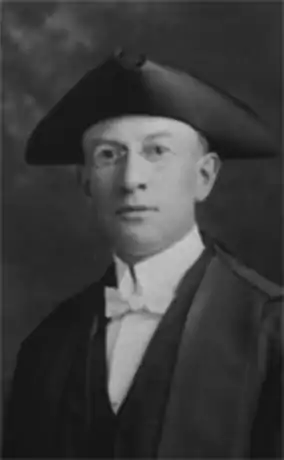Edgar Nelson Rhodes
Edgar Nelson Rhodes, PC (January 5, 1877 – March 15, 1942) was a Canadian parliamentarian from Nova Scotia.
Edgar Nelson Rhodes | |
|---|---|
 | |
| Premier of Nova Scotia | |
| In office July 16, 1925 – August 11, 1930 | |
| Monarch | George V |
| Lieutenant Governor | James Robson Douglas James Cranswick Tory |
| Preceded by | Ernest Howard Armstrong |
| Succeeded by | Gordon Sidney Harrington |
| 15th Speaker of the House of Commons of Canada | |
| In office January 18, 1917 – March 5, 1922 | |
| Monarch | George V |
| Governor General | The Duke of Devonshire Baron Byng of Vimy |
| Prime Minister | Sir Robert Laird Borden Arthur Meighen |
| Preceded by | Albert Sévigny |
| Succeeded by | Rodolphe Lemieux |
| Senator for Amherst, Nova Scotia | |
| In office July 20, 1935 – March 15, 1942 | |
| Appointed by | R. B. Bennett |
| Member of the Canadian Parliament for Richmond—West Cape Breton | |
| In office August 11, 1930 – July 20, 1935 | |
| Preceded by | John Alexander Macdonald |
| Succeeded by | The electoral district was abolished in 1933. |
| Member of the Nova Scotia House of Assembly for Hants County | |
| In office June 25, 1925 – August 11, 1930 | |
| Preceded by | James W. Reid John A. Macdonald |
| Succeeded by | Alexander S. MacMillan |
| Member of the Canadian Parliament for Cumberland | |
| In office October 26, 1908 – December 6, 1921 | |
| Preceded by | Hance James Logan |
| Succeeded by | Hance James Logan |
| Personal details | |
| Born | January 5, 1877 Amherst, Nova Scotia |
| Died | March 15, 1942 (aged 65) Ottawa, Ontario, Canada |
| Nationality | Canadian |
| Political party | Conservative Party Nova Scotia Conservative Party |
| Spouse(s) | Mary Grace Pipes m, 1905 |
| Profession | Lawyer |
| Cabinet | Federal: Minister of Fisheries (1930–1932) Minister of Finance and Receiver General (1932–1935) |
He was first elected to the House of Commons of Canada in 1908 as a member of the Conservative Party. In January 1917, he became Speaker of the House of Commons of Canada when his predecessor, Albert Sévigny, was appointed to the Canadian Cabinet. Rhodes was retained in the position following the 1917 election that fall, becoming the third Speaker since James Cockburn to preside over more than one Parliament. In 1921, he was made a member of the Queen's Privy Council for Canada before retiring from politics to become president of the British-American Nickel Company, whose previous president had been James Hamet Dunn.
The company failed in 1925, and he returned to provincial politics. Prior to the 1925 provincial election, he was asked to become leader of the Nova Scotia Conservative Party after the leader of the party, W. L. Hall, was assaulted on the waterfront. Rhodes took over the party and led it to victory in the 1925 election. The Conservatives defeated a Liberal government that had been in power for forty-three years but had been, in its last years, wracked by an economic downturn and severe labour unrest among miners in Cape Breton.
Rhodes ran on a Maritime Rights platform, promising to curtail federal influence and stop the exodus of people from the province. The Tories more than doubled their seats in the Nova Scotia House of Assembly, winning forty out of forty-three seats. An important factor in their victory was the failure of the governing Liberals to resolve a long strike by the province's coal miners. When Cape Breton coal miner William Davis was killed by company police in a confrontation on June 11, voters looked to the Tories for solutions. Rhodes engineered a settlement of the dispute and appointed a royal commission. The new government later introduced pensions for teachers and allowances for widowed mothers.
His government also abolished the Legislative Council, the province's appointed Upper House, but first had to go to the Judicial Committee of the Privy Council to obtain permission to appoint enough new members to the Council to secure a vote for its abolition.
The Rhodes government was re-elected in 1928 with a reduced majority. He returned to federal politics to become Minister of Fisheries under Prime Minister R.B. Bennett. From 1932 to 1935, he served as federal Finance Minister, and, despite the Great Depression, handed down austere budgets that increased taxes and reduced spending.
He was appointed to the Senate of Canada three months before the 1935 federal election that routed Bennett's government. He remained a Senator until his death in 1942 in Ottawa. He is buried in Ottawa's Beechwood Cemetery.
On July 12, 1905, he married Mary Grace Pipes, daughter of William Thomas Pipes, Rhodes' law partner and Premier of Nova Scotia from 1882 to 1884. They had one son, Edgar Nelson, and one daughter, Helen Sybil.
References
- Edgar Nelson Rhodes – Parliament of Canada biography
- "Hon. Edgar Nelson Rhodes". The Speakers of the Canadian House of Commons. Parliament of Canada.
- Edgar Nelson Rhodes fonds, Library and Archives Canada